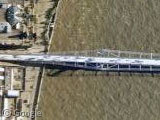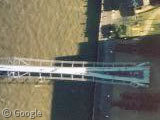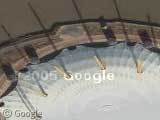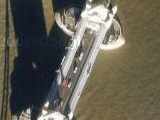Millennium Bridge, London
Tuesday, 22nd May 2007 by Alex Turnbull
The first pedestrian crossing of London's Thames river in over one hundred years, the Millennium Bridge was conceived as part of the high-profile Millennium Project. Opened on the 10th of June 2000, it was closed again just three days later when it became apparent that the large numbers of people crossing it were causing the whole structure to sway nauseatingly...
The initially small natural vibrations of the bridge encouraged the pedestrians to walk in sync with the movement - which only served to amplify the effect. These vibrations began to occur when there were comparatively few people on the bridge, so by the time there were around 2,000 people on it at once, the wobbling had become pretty dramatic [Youtube link].
Lateral movement of this type in bridges was well known (most famously having caused the complete collapse [Youtube link] of the Tacoma Narrows bridge) - yet this driven harmonic motion caused by the movement of pedestrians remained unanticipated throughout the pre-construction analysis of the bridge.
The Millennium Bridge was closed from June 2000 until February 2002, and even though the problem has now been resolved, it will forever be known simply as The Wobbly Bridge.
More about the London's Millennium Bridge, as ever, at Wikipedia.
Thanks to Rory and Tim.






‘nauseatingly’? Good word (if a little bit made up maybe?).
DHM caused by pedestrians not seen before? Huh? Why do you think soldiers break step when crossing suspension bridges? Any small suspension bridge will demonstrate this behaviour if enough people walk on it. Now gone, I think, but the Shacking Briggy over the River Dee near Aberdeen was a classic example of this in action.
That’s a darn good point xman. That’s what I get for believing something on Wikipedia…
Post updated.
Crazy stuff.
Many years ago, when visiting San Francisco or some other city, I think a tour guide told us that the army was no longer allowed to march across the bridge because of the syncronized pounding of the feet caused similar vibrations in the bridge.
Why do soldiers break step in marching over a bridge? http://www.answerbag.com/q_view/175566
Oh, and cookie monster: nauseatingly 🙂
I believe that soldiers marching in step thing was mythBUSTED by the Mythbusters.
The whole vibrating bridges thing is almost always misunderstood. In this particular case, if was psychology that caused the problem. Any structural engineer in the world would have looked at the design of that bridge and said it would not have vibration problems.
The bridge used a type of suspension that was (according to the Arup engineers describing it on TV) completely novel. Instead of having the suspension pylons going straight up (like the golden gate bridge) they went out at an angle. The vertical component of the tension in the cables is sufficient to hold the thing up. The horizontal component is balanced by the other pylon.
Now there’s nothing wrong with this. The same physics that governs other suspension bridges applies here. But why did this one wobble? The bridge is very light, so it can be set in motion by a comparatively small force. There’s nothing wrong with that either. The Millenium bridge over the Tyne bounces when I jump up and down.
The problems at the Millenium bridge in London were a combination of biomechanics and psychology that no-one (at least no structural engineer) had anticipated. Whenever we place a foot on the ground, it exerts a small sideways force. It is assumed that in a group of lots of people randomly milling about that these small forces will be randombly distributed and will cancel each other out. As it turns out, for a lightweight bridge, the random coincidence of a few people walking in step is enough to start the bridge moving very, very slightly. This small vibration then influences other people on the bridge to walk in step, and before long everybody is walking in step, and the bridge is vibrating like in the video.
Other things: Soldiers break step on bridges because of the very regular impulsive vertical force that is transmitted into the structure, not the horizontal force.
The tacoma narrows bridge was excited to resonance by quasi-periodic turbulent forces due to the wind travelling down the valley. Modern bridges are tested in wind tunnels and in software simulations to ensure they do not suffer similar fates. I think they might get damped, too.
Finally, apologies to James and Alex for trolling up their nice website.
Myth Busters, eh? If their bs improves a bit, they might be on par with Wikipedia.
Google “Hyatt Regency collapse” for some scary stuff about the hotel walkway collapse in Kansas City, in ’81.